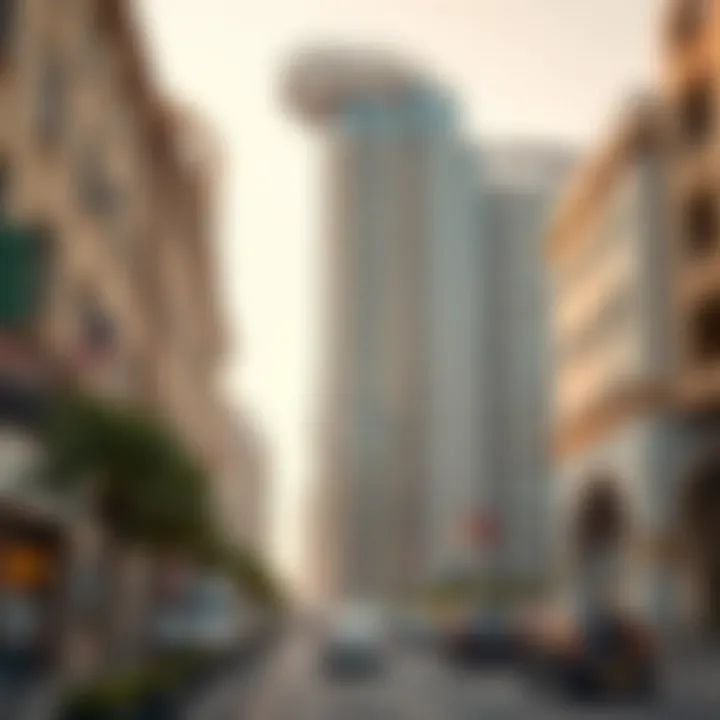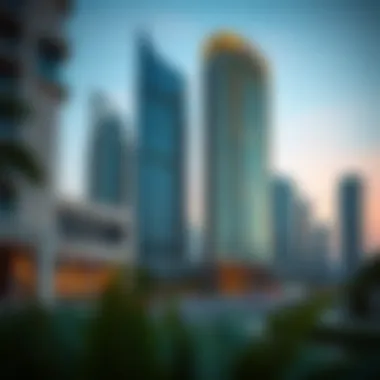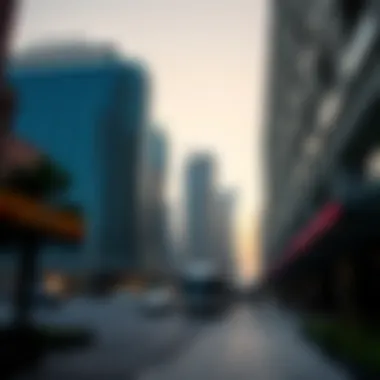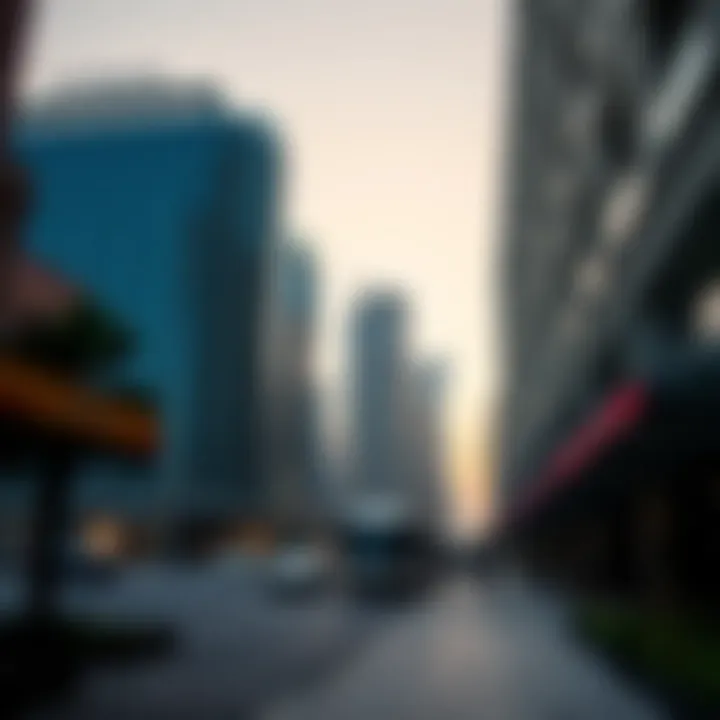Exploring European Influence in Dubai's Growth


Intro
The relationship between Europe and Dubai presents a fascinating picture of cultural and economic exchanges. As Dubai emerges as a major global hub, its connection with European influences not only shapes its architectural landscape but also fuels its investments and cultural diversity. With a bustling trade environment and an attractive real estate sector, the city has drawn the attention of investors and homebuyers, looking for opportunities that resonate with the modern spirit yet acknowledge the past.
In this comprehensive examination, we are going to explore how European architectural styles manifest in Dubai's skyline, the rich cultural exchanges that are taking place, and the investment trends that can be observed in the present landscape. This aligns with the growing interest from property seekers and those who wish to understand how European influences play a crucial role in shaping Dubai's unique identity.
By analyzing current market trends and investment opportunities, the discussion will offer valuable insights for investors and enthusiasts alike. Whether you are a property hunter or just curious about the evolution of Dubai’s real estate scene, this article provides a framework for understanding the ongoing connections between Europe and this dynamic city.
Foreword to Dubai's European Influence
The intertwining of Europe and Dubai may appear like an unlikely pairing at first glance. However, a deep dive into this connection reveals layers of cultural, architectural, and economic influences that have significantly shaped Dubai's identity. Understanding the European impact is essential, especially for investors, property seekers, and those interested in the rich tapestry of Dubai’s landscape. This examination unpacks key historical pathways, explores the evolution of architectural styles, and highlights cultural exchanges that demonstrate the strong European fingerprints throughout the emirate.
In exploring these aspects, one gains insight into the various benefits and opportunities that arise from this relationship. European nations have not only contributed to the physical skyline of Dubai but have also played an integral role in its commercial growth and international outreach. Analyzing this influence opens doors for potential investors who wish to tap into the burgeoning market, as it offers a glimpse into not only where Dubai has been but also where it is headed.
Historical Context
Delving into the historical context sets the stage for understanding how these influences materialized. The late 19th and early 20th centuries were pivotal. The discovery of oil in the mid-20th century transformed Dubai from a small trading port into a global hub. Many European firms recognized the potential in this burgeoning economy, steadily establishing a presence. Countries like the United Kingdom and France, through commerce and trade, were early pioneers in shaping Dubai's infrastructure and services.
The 1971 unification of the UAE further opened the floodgates for European investment and collaboration. British education systems, engineering firms, and architectural influences coalesced into a unique fabric of Dubai's narrative. For example, firms such as Foster and Partners left indelible marks through designs of iconic structures like the Burj Khalifa. This historical legacy still serves as a bedrock for current relations.
The Role of European Countries in Dubai's Development
European countries have worn many hats in Dubai’s development narrative. From early engineers to modern architects, they have left footprints at various junctures. Notably, the UK has deeply influenced corporate practices in the region. The creation of free zones tailored to foreign investment, such as the Dubai Multi Commodities Centre, reflect UK-inspired models. The free zone continues to attract European businesses, showcasing how frameworks established long ago maintain relevance today.
Meanwhile, countries like Germany and Italy contribute significantly in sectors such as technology and fashion. Their influence extends beyond investment alone; cultural exchange flourishes through events like the Dubai Design Week, highlighting European design sensibilities.
In actionable terms, these evolutions create a fertile ground for investors. Not only do they open avenues for growth in real estate but the collaboration in various sectors presents opportunities for European entities to enter a vibrant and dynamic market.
"The link between Dubai and Europe is not just historical; it is a living relationship that continues to grow and evolve, offering myriad opportunities for those willing to engage."
In summation, recognizing the European influence on Dubai provides critical insight into the city's past, present, and future, making this exploration a worthwhile endeavor for anyone engaged in the Dubai real estate market. By understanding who contributed to the emirate's growth, stakeholders can better navigate the winding paths of investment and cultural exchange.
Architectural Styles Inspired by Europe
The intersection of European architectural styles and Dubai's landscape plays a vital role in shaping the city’s identity. As architectural marvels rise against the skyline, they narrate a tale of cultural confluence, reflecting both traditional and modern influences. Understanding these architectural styles offers insights not only into the aesthetic choices of the city but also into the values and aspirations of its residents and developers. This blending creates spaces that resonate with both locals and visitors alike, enriching Dubai's real estate appeal.
Key European Architectural Trends
Dubai has been a canvas for numerous architectural trends borrowed from various European styles, each with its own unique flair. Key among these styles are:
- Gothic Revival: This style is evident in structures that boast pointed arches, ribbed vaults, and detailed facades, seen in some commercial buildings.
- Neoclassical Influences: Characterized by grand columns and symmetrical shapes, this influence adds a touch of grandeur to public spaces in Dubai, reminiscent of ancient Greek temples.
- Modernist Trends: The influence of Modernist architecture, focusing on functionality and simplicity, is at the forefront in Dubai’s skyline, upholding minimalistic designs that maximize space and light.
- Art Deco: This trend can be seen in the use of vibrant colors and geometric shapes, often found in hotels and leisure spots, bringing a playful yet sophisticated vibe.
These trends not only symbolize architectural evolution but also point to a more extensive narrative of globalization and modernization that pervades Dubai, catering to a diverse population and a booming tourism industry.
Notable European-Inspired Structures in Dubai
Some structures in Dubai stand out because they vividly encapsulate European architectural styles, drawing interest from both investors and tourists. Notable examples include:
- Burj Khalifa: While predominantly modern, its design contains elements that can be traced back to Islamic architecture, which has a strong European influence, particularly from its proportions and materials.
- The Opus by Zaha Hadid: This building innovatively merges free-flowing forms often associated with European avant-garde design, making it an icon of contemporary architecture.
- Sofitel Dubai Downtown: Inspired by French aesthetics, this hotel combines luxury with elegant design, showcasing how European influence can merge with local culture.
- Dubai Opera: Resembling the traditional dhow, it serves as a perfect example of how European styles can harmonize with local maritime heritage, reflecting versatility and creativity.
These buildings not only highlight the architectural prowess of European-inspired designs but also provide investors with unique opportunities. As they become landmarks of the city, they also elevate property values and attract global attention.
"Architecture is the thoughtful making of space." This statement resonates perfectly with Dubai’s architectural scene, a blend where European inspirations meet local ambitions, shaping both the skyline and the socio-economic landscape.
Cultural Exchanges between Europe and Dubai
Cultural exchanges between Europe and Dubai present a fascinating mosaic of interactions that significantly enrich both regions. These exchanges not only highlight the blending of traditions but also foster mutual understanding and appreciation, which is paramount in an increasingly globalized world. In the context of Dubai, a bustling hub of commerce and tourism, European influences are particularly prominent, establishing cultural dialogues that span art, fashion, cuisine, and lifestyle. This section will explore the various facets of cultural exchanges that shape the experience of residents and visitors alike, delving into the specialized benefits these interactions yield for various stakeholders such as investors, homebuyers, and renters.


The Impact of European Art and Fashion
The intersection of European art and fashion with Dubai's vibrant landscape cannot be overstated. You can find galleries showcasing contemporary European artists, reflecting both the innovative spirit and the enduring classicism of European art traditions. Major art events like Art Dubai invite local and international artists, promoting dialogue and collaboration, blurring the boundaries of cultures. European styles influence local designers, creating a hybrid fashion scene mixing traditional Emirati styles with elements from Milan, Paris, and London.
Investors benefit from this cultural blend as art markets gain traction. Galleries and art fairs attract affluent buyers, creating new avenues for real estate development, particularly in artsy neighborhoods. Additionally, the mix nudges the tourism sector, drawing art lovers to Dubai to explore the unique offerings
Furthermore, fashion weeks held in Dubai often feature European designers, further integrating continental trends into local culture. Local boutiques proudly showcase pieces that capitalize on this dual heritage, offering consumers a taste of European flair fused with Dubai’s rich textures. Collaborations between European and Emirati designers often result in clothing lines and products that not only appeal to the local market but also find resonance among tourists, thus enhancing market opportunities.
Culinary Influences from Europe
Food is perhaps the most celebrated medium through which cultures communicate. European culinary influences in Dubai are present at every corner, from gourmet restaurants to casual eateries. French bistros and Italian trattorias share space with traditional Middle Eastern fare. This rich tapestry of flavors challenges palates and introduces Dubai residents to diverse cuisines.
The casual dining scene often features European-inspired menus, making it a hotspot for expatriates and tourists craving a taste of home. Many skilled chefs showcasing their talent are from Europe, contributing to the culinary quality and variety. Taste buds that wander from paella to pasta make for a culinary adventure, paralleling Dubai's reputation as a melting pot of cultures
The emergence of food festivals highlighting European cuisines has also gained popularity, giving rise to events that celebrate seasonal European fare, regional specialties, and fusion dishes. Engaging culinary experiences not only promote tourism but also create community events that strengthen bonds between the local and expatriate populations.
Through these exchanges, residents and visitors become ambassadors of their culinary traditions, fostering goodwill and a shared sense of community, ultimately enriching Dubai's multicultural identity. Variety in cuisine helps investors explore opportunities in the restaurant industry, ensuring they are ahead of Culinary trends.
European influences in art and cuisine have become part of Dubai's DNA, making it an attractive destination for cultural connoisseurs and those seeking investment opportunities.
In summary, the cultural exchanges between Europe and Dubai represent a vital aspect of the relationship between the two. They pave the way for an enriched experience that benefits both the local population and visitors, cultivating a robust sense of shared identity and community and creating new economic opportunities for various stakeholders in the real estate and tourism industries.
Real Estate Trends Reflecting European Interests
The real estate sector in Dubai has turned into a key market, attracting attention not just from local buyers but also from across Europe. As this article highlights, European interests have significantly shaped the dynamics of Dubai’s property market. Understanding these trends is vital for investors and stakeholders who are trying to navigate this vibrant environment. It illuminates what appeals to European buyers and why their investment strategies are crucial in enhancing the city's economic framework.
Investment Trends from Europe
In recent years, European investors have been increasingly attracted to Dubai's real estate market. This trend is influenced by various factors such as competitive property prices compared to other major global cities. The market is perceived as a safe haven, especially amid fluctuating economic climates in Europe.
Additionally, benefits like tax-free ownership and straightforward property regulations have made it irresistible for European buyers. Key investment trends include:
- Luxury Developments: Europeans lean toward high-end properties, particularly in areas known for luxury living, such as Palm Jumeirah and Downtown Dubai. These areas are not only visually stunning but also come with a promise of high returns on investment.
- Off-Plan Properties: Many European investors favor off-plan property investments. The advantage here is the potential for capital appreciation before completion, often packaged with flexible payment plans.
- Short-Term Rentals: Driven by the booming tourism sector, there’s a growing interest in properties that can be rented short-term. European buyers often capitalize on this by investing in apartments that appeal to tourists, offering a dual benefit of personal use during holidays and rental income.
Understanding these trends not only assists in marketing strategies but also provides insights into future developments that may resonate with European buyers.
Popular Neighborhoods among European Buyers
Certain neighborhoods in Dubai have become hotspots specifically due to their appeal to European tastes and lifestyles. These areas offer amenities and environments that feel familiar while also providing unique attractions that residents can enjoy. Key neighborhoods include:
- Dubai Marina: Known for its vibrant waterfront lifestyle, Dubai Marina attracts Europeans seeking leisure, dining, and entertainment options. It provides a fantastic view of the skyline while being in proximity to beaches and parks.
- Jumeirah Beach Residence (JBR): This area is loved for its luxurious beachfront homes and a plethora of leisure activities available at the doorstep. The European lifestyle is mirrored here through cafés, boutiques, and community events.
- Downtown Dubai: Often seen as the heart of Dubai, this area is famous for its iconic landmarks, such as the Burj Khalifa. It’s an attractive location for high-net-worth Europeans looking for high-value properties.
"Investing in real estate in Dubai is not just about buying a property; it’s about securing a lifestyle that resonates with global standards of luxury and convenience."
These neighborhoods underline how cultural preferences shape real estate decisions for European buyers. They not only seek a property but also a community with shared values and lifestyle preferences, making the dynamics of the Dubai real estate market even more intricate.
Understanding these aspects will allow investors and realtors to tailor their approach in a way that resonates deeply with potential European buyers, viewing the investment not merely through monetary lenses but also through lifestyle aspirations.
European Presence in Dubai's Business Landscape
The confluence of European business interests and the vibrant, ever-evolving market of Dubai illustrates a compelling narrative of mutual growth and opportunity. As a global business hub, Dubai attracts various firms from Europe, contributing significantly to its economic tapestry. This relationship benefits both parties, as European brands and companies not only find a foothold in the Middle East but also enhance the diversity and dynamism of Dubai's economy.
One of the fundamental aspects of the European presence in Dubai’s business landscape is the level of trust and quality associated with European brands. They often come with an image of reliability and excellence, which is particularly crucial in sectors like real estate, finance, and luxury goods. These industries thrive in the unique setting Dubai offers—tax incentives, strategic geographic location, and a growing expatriate population that appreciates and seeks high-quality products and services.
Furthermore, the European companies act as catalysts for innovation. They introduce advanced technologies, sustainable practices, and modern management approaches that can uplift local businesses. In this sense, the interaction paves the way for professional development and the sharing of expertise, which is beneficial for both expatriates and local firms.
European Companies and Their Contributions
European companies have made significant strides in shaping Dubai’s economic landscape. Renowned names such as Siemens, Bosch, and BASF have established a strong presence in the region, revolutionizing various sectors such as engineering, technology, and chemicals. Their contributions are multi-faceted:


- Job Creation: European firms have been pivotal in creating job opportunities for both locals and expatriates, addressing the ever-growing demand for skilled labor in Dubai.
- Innovation: These companies often bring cutting-edge technologies and sustainable practices that are not commonplace in the region. For instance, Siemens is involved in smart city solutions, making urban life more efficient and connected.
- Quality Assurance: There’s a level of assurance that comes with European companies. They often adhere to stringent quality standards which have raised the bar for local businesses.
Additionally, the contribution of these firms extends beyond mere economics; they play a vital role in cultural exchange, introducing European business practices and corporate cultures that enrich the local environment. This synergy helps to create a diverse business ecosystem characterized by competition and collaboration.
Trade Agreements and Economic Benefits
Trade agreements between the United Arab Emirates and European nations significantly augment the European presence in Dubai. These agreements pave the way for smoother trade relations, reducing tariffs and enhancing product accessibility. The EU-UAE Trade Agreement, for instance, serves as a blueprint for potential trade enhancements, yielding numerous economic benefits:
- Increased Trade Volume: Lower tariffs mean that European products become more competitive in Dubai and vice versa, fostering greater import and export volumes.
- Investment Opportunities: With streamlined processes and clear regulations, more European investors feel secure entering the market, leading to increased foreign direct investment.
- Market Access: A stronger alignment through trade agreements enables not just better access for European companies but also opens up Dubai markets for indigenous products to reach European consumers more easily.
"The foundation of trade agreements lies in mutual respect and understanding, setting the stage for economic prosperity for all involved parties."
The trajectory of European involvement in Dubai’s business landscape indicates that this relationship will likely deepen and expand, reinforcing the economic fabric of both regions. As investors, researchers, and stakeholders reflect on these dynamics, the potential for increased collaboration continues to present itself as a promising avenue for growth.
Tourism: The Link between Europe and Dubai
Tourism acts as a vital artery connecting Europe and Dubai, enriching both regions through cultural exchange and economic interaction. The influx of European tourists not only bolsters Dubai's economy but also fosters a unique blend of traditions, tastes, and experiences. This section seeks to illuminate the significance of tourism in strengthening the bonds between Europe and Dubai, exploring travel patterns and festivities that further intertwine the two regions.
Travel Patterns of Europeans to Dubai
European travelers have shown a marked interest in visiting Dubai over the past two decades. Factors that influence this trend include:
- Direct Flight Accessibility: Many European cities have direct flights to Dubai, cutting down travel time significantly. Airlines such as Emirates, British Airways, and Lufthansa cater to millions of tourists, making the journey smoother than ever.
- Diverse Attractions: From the iconic Burj Khalifa to expansive shopping malls and desert adventures, Dubai’s offerings are diverse. It's not uncommon for family groups to seek a combination of leisure and adventure, which Dubai efficiently provides.
- Luxury Shopping and Experiences: European tourists often come to enjoy high-end shopping and luxurious experiences. The city's reputation as a shopping paradise, especially during the Dubai Shopping Festival, pulls many into its glittering malls and souks.
- Mild Climate: Many Europeans escape the harsh winters to indulge in Dubai's temperate climate, particularly between November and March. This seasonal migration significantly boosts tourism during these months.
The statistics back this up: In 2022 alone, Dubai welcomed over 3.5 million European visitors, accounting for approximately 30% of its total tourist population. Europeans flock to Dubai not just for vacations but also for business or educational opportunities. Generally it showcases a relatable bridge to cultural, economic, and social facets between the two regions.
European Festivals and Events in Dubai
Events and festivals play a key role in cementing the European presence in Dubai. They offer lively platforms to celebrate culture, art, and community.
- Dubai Shopping Festival: This annual event lures Europeans with great deals and attractions. Visitors receive the chance to win car prizes or even cash with raffles, prompting throngs of shoppers to descend on the city.
- Art Dubai: As one of the foremost art fairs in the Middle East, it attracts artists and art aficionados from Europe. The fair showcases a blend of contemporary artworks, fostering exchanges and collaborations.
- European Film Festival: A seasonal affair that highlights a selection of European films, creating a cinematic bridge. This event allows audiences to engage with diverse cultures and storytelling styles.
- Cultural Nights: Various venues in Dubai, such as the Dubai Opera or the Art Dubai venue, frequently host evenings dedicated to European culture—think music festivals featuring Western classics or evenings focused on Italian or French cuisine.
"Tourism not only generates revenue but also enriches Dubai's cultural fabric."
Educational Exchanges and Academic Partnerships
The dynamics between Europe and Dubai extend into the realm of education, where collaborative academic partnerships and exchanges significantly benefit both regions. These educational links have transformed not only the academic landscape in Dubai but have also enhanced the cultural and intellectual fabric of the city.
The education system in Dubai has, over recent years, emerged as a harmonious blend of local and international influences. This is largely due to proactive programs designed to cultivate academic exchanges with prestigious European institutions. Such collaborations pave the way for students to gain insights into diverse curricula while also bringing European educational standards to the forefront of Dubai's academic offerings.
Collaborative Programs with European Institutions
Collaborative programs serve as the cornerstone for educational exchanges between Dubai and Europe. Many universities in Dubai have established partnerships with renowned European educational institutions, such as the University College London and the University of Edinburgh. These collaborations often result in joint degree programs, where students can gain credible qualifications recognized both locally and internationally.
Furthermore, these institutions actively encourage exchange programs that allow students from Dubai to experience studying abroad in Europe while also welcoming European students to Dubai. Some key benefits of such collaborative efforts include:
- Cultural Exchange: Students gain exposure to diverse cultures which enhances intercultural understanding.
- Joint Research Opportunities: Collaborative research initiatives can emerge, tackling global challenges through a united front.
- Career Advancement: The global exposure helps foster skills that are attractive to future employers.
"Collaborative programs open doors to new perspectives, enrich the learning experience, and align education with global standards."
Studying in Dubai: Perspectives for European Students
For many European students, studying in Dubai offers a unique opportunity to immerse themselves in a cosmopolitan environment that blends tradition and modernity. The UAE in general, and Dubai in particular, has positioned itself as an educational powerhouse, boasting numerous internationally accredited institutions.
European students pondering over studying in Dubai might consider the following factors:
- High-Quality Education: Many institutions in Dubai maintain affiliations with European universities, ensuring that the quality of education meets global standards.
- Diverse Student Population: Dubai's multicultural environment welcomes students from around the world, fostering an enriching social experience.
- Professional Opportunities: Given that Dubai is a hub for many multinational companies, European students find a multitude of internship and job opportunities post-graduation.
For more in-depth insights into education systems and academic collaborations, visit Wikipedia.


Engagement in educational exchanges is setting the stage for a brighter, interconnected future not just for students, but also for the broader societal and economic fabric of both Europe and Dubai.
Challenges in the European-Dubai Relationship
The relationship between Europe and Dubai is not without its hurdles. While the ties are characterized by fruitful engagements in architecture, business, and culture, there are significant challenges that must be navigated for a lasting connection. This section probes the nuances of these challenges, providing insight into cultural misunderstandings and economic risks that could weigh down investment strategies.
Cultural Misunderstandings
Cultural dynamics between Europe and Dubai can sometimes feel like walking a tightrope. The inherent differences in values, traditions, and lifestyles can lead to misunderstandings that complicate interactions. For instance, Europeans may view Dubai's rapid modernization and exuberance as a testament to progress, while Emiratis might see these actions as a departure from their cultural roots.
This divide is often reflected in social customs. Europeans accustomed to a more liberal social structure sometimes find the strict norms in Dubai a bit confounding. When a tourist unknowingly offends local customs, it can spark ruffled feathers, leading to a stigma that trickles down to businesses, making European companies hesitant to invest extensively. Understanding these cultural intricacies, therefore, is crucial for fostering smoother relations and ensuring mutual respect.
To bridge these gaps, both sides need to engage in open dialogue. Consider initiatives like cultural workshops or exchange programs that could provide a platform for both Europeans and Emiratis to learn about each other's customs and traditions. As they say, "When in Rome, do as the Romans do." That spirit of adaptability can pave the way for a more harmonious relationship.
Economic Downsides for Investors
While numerous Europeans invest in Dubai's vibrant real estate market, there lurk potential pitfalls. One significant concern is the unpredictability of the market. Real estate prices can behave like a rollercoaster, sending investors on a dizzying ride that few are prepared for. Investors coming from countries with stable economies may not anticipate the sudden fluctuations that characterize markets in rapidly developing regions like Dubai.
Moreover, differing legal frameworks can pose another challenge. The property laws governing foreign investments can be hard to decipher. Investors might find themselves entangled in red tape, especially if they are unaware of local regulations or fail to seek the right legal advice beforehand. Not aligning with local expectations can lead to unfavorable outcomes and sour the investment experience.
Furthermore, geopolitical factors can also dampen investor enthusiasm. European markets are often seen as stable, whereas Dubai's dependence on global economic tides makes it susceptible to external shocks. For instance, diplomatic rifts could have ripple effects on expat living conditions and, consequently, the vibrancy of the property market.
In essence, while opportunities abound in Dubai, investors must tread carefully. Balancing the allure of a flourishing market against potential cultural and economic pitfalls is crucial to making informed decisions. A thorough understanding of these challenges not only equips investors with strategies to mitigate risks but also enhances the overall investment experience.
"An ounce of prevention is worth a pound of cure." Being prepared to navigate this complex landscape is vital.
Optimizing for success in Dubai's real estate market demands constant vigilance and adaptability. Striking this fine balance is what true investors need to thrive in this unique intersection of culture and commerce.
Future Prospects: Europe’s Role in Dubai's Expansion
The relationship between Europe and Dubai has evolved significantly over the years, shaping the economic landscape of the Gulf region. As we look to the future, this dynamic interaction promises to bring about further transformation, particularly in real estate and cultural exchanges. The potential benefits are manifold, particularly for investors, homebuyers, and industry analysts eager to uncover opportunities.
Emerging Trends in Real Estate Investment
Real estate investment is one of the most notable areas where European interests intersect with Dubai's ambitions. Recent years have seen a surge in European investors exploring the Dubai property market, attracted by favorable investment climates and potential high returns. Several trends are emerging that signal a stronger European presence in this sector:
- Preference for Luxury: European investors often gravitate toward high-end properties. Developments like the Burj Khalifa District and the upscale Dubai Marina have become hotspots due to their luxurious offerings and exclusive amenities.
- Sustainable Developments: Sustainability has become a priority, both in Europe and the UAE. Projects that emphasize eco-friendly practices, such as The Sustainable City, appeal to environmentally-conscious investors.
- Regulatory Reforms: Recent regulatory changes aimed at easing foreign investment in Dubai have not gone unnoticed. For instance, the introduction of longer-term visas for investors encourages European nationals to consider long-term commitments in the market.
The response of the market to these trends will be a key determinant in sustaining investment flows, and continued adaptation to investor needs is paramount for success.
Long-Term Cultural Collaborations
Beyond the economic dimension, cultural exchanges have the potential to deeply influence future relations between Europe and Dubai. Recent collaborations reveal a commitment to strengthening ties through shared cultural ventures. Noteworthy aspects include:
- Art Exhibitions and Festivals: Events such as Art Dubai, which attract European artists and galleries, are crucial for fostering cultural links. These gatherings nurture artistic dialogue and often lead to exhibition partnerships between European institutions and local artists.
- Culinary Partnerships: The gastronomic scene in Dubai has benefited from European influences, with renowned chefs setting up restaurants that showcase French, Italian, and Spanish cuisines. This blend enhances not only the dining experience but also cultural appreciation.
- Academic Exchanges: Institutions in Dubai are increasingly forming collaborations with prominent European universities. Such initiatives lay the groundwork for knowledge sharing and programs that enhance educational offerings for both European and Emirati students.
Quote:
Epilogue
The exploration of the intricate ties between Europe and Dubai ultimately showcases how prevalent these influences are in shaping both the city’s architecture and its cultural fabric. A convergence of European style and design in Dubai has not only transformed the city’s skyline but also created spaces that are appealing to a diverse global clientele. This article has illuminated several key elements that reinforce the significance of this relationship for investors, homebuyers, and real estate agents.
Summary of Findings
- Architectural Impact: European influences are clearly observable in the stunning architectural structures throughout Dubai. From the opulent Burj Khalifa to the less celebrated yet striking European-style developments in Jumeirah, the styles vary widely but consistently bring a touch of class and sophistication.
- Cultural Exchange: The infusion of European art and cuisine has enriched Dubai’s multicultural landscape. Restaurants and galleries reflect various European traditions, catering to the tastes and preferences of an increasingly diverse demographic.
- Investment Trends: European investors have shown a keen interest in Dubai's promising real estate market. The luxury apartments in Downtown Dubai and the waterfront properties in Dubai Marina are prime examples of areas where European buyers are actively investing, leading to a surge in property values.
- Educational Collaborations: Partnerships between European educational institutions and Dubai-based universities promote an exchange of knowledge that benefits students from both regions, fostering a more interconnected world.
- Challenges and Opportunities: While cultural misunderstandings and economic challenges exist, they present opportunities for dialogue and improvement in future collaborations.
The findings serve as a reminder that the dynamic interplay between the corners of Europe and the spark of Dubai creates an environment ripe for growth and cultural richness. These intersections continue to fuel opportunities and invite further exploration.
Final Thoughts on the European Influence in Dubai
The European influence in Dubai is not merely superficial; it weaves a complicated narrative of ambition, innovation, and cultural integration. This relationship is a barometer of Dubai’s aspirations to be a leading global city, which attracts not only tourists but also investors seeking to capitalize on this burgeoning market.
The future holds great promise as both regions continue to engage with one another. The rich tapestry of culture, architecture, and commerce that emerges from this relationship highlights a shared vision for progress and global cooperation. For investors and homebuyers, understanding this influence presents a significant edge in the thriving real estate arena. The ability to recognize and appreciate these often-overlooked connections will undoubtedly play a pivotal role in both navigating the market and making informed decisions.
As Dubai continues its journey into modernity while holding onto its roots, the European thread in its narrative promises to weave even more significant stories for generations to come.



